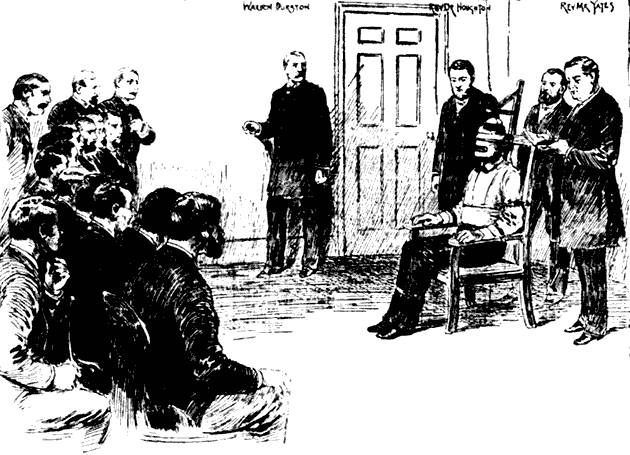William Kemmler (Boston, 9 de maio de 1860 - Auburn, 6 de agosto de 1890) foi a primeira pessoa a ser executada numa cadeira elétrica.
Após ter assassinado a machadadas Tillie Ziegler, a sua companheira, a 29 de março de 1889, Kemmler foi condenado à morte e executado a 6 de agosto de 1890, às 07.00 horas, na prisão Auburn, no estado de Nova Iorque.
No entanto, após 17 segundos com uma tensão de mais de 1000 volts
aplicada sobre o seu corpo, William Kemmler voltou a respirar, sendo
ligada novamente dessa vez por dois longos minutos, gerando fumo na sala
de execução e causando vómitos em um dos presentes, e, assim, Kemmler
foi finalmente executado.
in Wikipédia
The first person in line to die under New York's new electrocution
law was Joseph Chapleau, convicted for beating his neighbor to death
with a sled stake, but his sentence was commuted to life imprisonment. The next person scheduled to be executed was William Kemmler, convicted of murdering his wife with a hatchet. An appeal on Kemmler's behalf was made to the New York Court of Appeals on the grounds that use of electricity as a means of execution constituted a "cruel and unusual punishment" and was thus contrary to the constitutions of the United States and the state of New York. On December 30, 1889, the writ of habeas corpus sworn out on Kemmler's behalf was denied by the court, with Judge Dwight writing in a lengthy ruling:
We have no doubt that if the Legislature of this State should undertake to proscribe for any offense against its laws the punishment of burning at the stake, breaking at the wheel, etc., it would be the duty of the courts to pronounce upon such attempt the condemnation of the Constitution. The question now to be answered is whether the legislative act here assailed is subject to the same condemnation. Certainly, it is not so on its face, for, although the mode of death described is conceded to be unusual, there is no common knowledge or consent that it is cruel; it is a question of fact whether an electric current of sufficient intensity and skillfully applied will produce death without unnecessary suffering.Kemmler was executed in New York's Auburn Prison on August 6, 1890; the "state electrician" was Edwin F. Davis. The first 17-second passage of 1,000 volts AC of current through Kemmler caused unconsciousness, but failed to stop his heart and breathing. The attending physicians, Edward Charles Spitzka and Carlos F. MacDonald, came forward to examine Kemmler. After confirming Kemmler was still alive, Spitzka reportedly called out, "Have the current turned on again, quick, no delay." The generator needed time to re-charge, however. In the second attempt, Kemmler received a 2,000 volt AC shock. Blood vessels under the skin ruptured and bled, and the areas around the electrodes singed. The entire execution took about eight minutes. George Westinghouse later commented that, "They would have done better using an axe", and a witnessing reporter claimed that it was "an awful spectacle, far worse than hanging".
in Wikipédia






Sem comentários:
Enviar um comentário